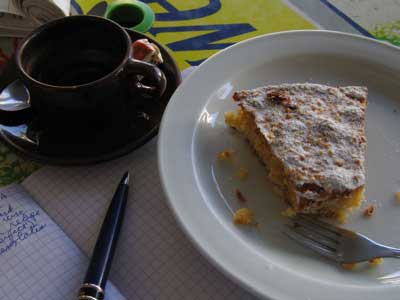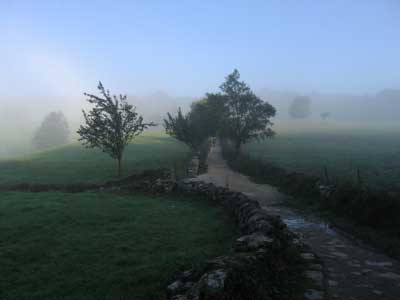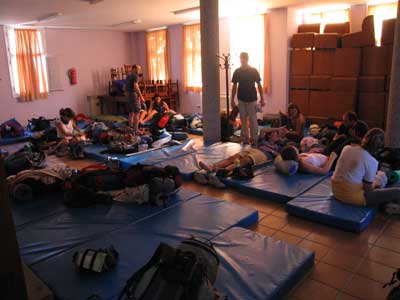
« Villafranca del Bierzo :: Santiago de Compostella »
September 23, 2004

The closer you get to Santiago de Compostella, the more crowded the Camino becomes. I blame it on the Catholic church. In order to receive the official “Compostella” certificate in Santiago the rules state that peregrinos must walk at least the final 100 km of the route, and cyclists must pedal at least the last 200 km. The result is that, as you reach these points along the way — let’s say Ponferrada (212 km from Santiago) for cyclists, and Saria (120 km) for walkers — you’ll notice a distinct jump in the number of people walking or riding with you. The Camino starts to resemble a kind of pedestrian autoroute, with backpack-laden walkers forming effective roadblocks every 100 meters or so, and overloaded cyclists jockeying for the cleanest through-line on the dirt path both fore and aft of you.
It seems that the journey to Santiago de Compostella has become “the thing to do” for far more people than I’d realized; Shirley MacLaine must wield a much greater influence than I’d given her credit for. And 2004 being a Holy Year meant that the numbers this year were even higher than in an average year.
For some of the many peregrinos I met the journey is still a genuine act of faith. But for far more, it seems to me, walking or riding the Camino is simply (or largely) “sport”, a physical test of some kind. By their hundreds they launch themselves onto the Camino at the latest acceptable point, accompanied by their chattering school-friends and their cell-phones, which ring in a variety of shrill and shattering tones. They stay up late at night talking in loud voices in the albergue common room, and rise reluctantly in the mornings to begin another day. They blister easily, and limp into the albergue in evident pain.
By Melide the albergues are filling up by early afternoon, and still the peregrinos keep arriving by the dozens — by the hundreds it seems — walking and cycling into town, all of them faithful followers of those dependable yellow arrows. All of them looking for a place to sleep.
Melide (where I will spend this night) is two days ride from Villafranca del Bierzo (the location of the previous blog entry), and just one day from Santiago de Compostella itself. There’s a real sense of imminent completion once you are this close to journey’s end; it almost seems safe to tempt fate and begin to think about the journey back to Paris, and the eventual flight home. But I will fight the urge.
Last night (the 22nd) was spent in Sarria, at a private albergue with the mysterious name of Albergue 31. That was a tiring day. The ride up to O Cebreiro is a long, relentless slog: 32 km of constant uphill, with about 800 meters gain in altitude. While the altitude was not the highest I’d encountered (recall the Col d’Izoard in the French Alps), the climb to O Cebreiro seemed to just go on and on.
Road signage in Spain is appalling: junctions are rarely labeled with either road numbers or the names of towns to which they lead; and you’ll almost never find a road sign which gives the mileage to the towns that lie ahead. Combine this with a lack of any decent maps and you’ll find yourself riding along with no real sense of where you are, or just how far you’ve still got to go.
Obedient to an explicit suggestion in my guidebook (“cyclists should follow the old N-VI”) I had chosen to follow the old N-VI towards O Cebriero. The guidebook’s accompanying sketch map shows this road passing through the town of Pedrafita, a stone’s throw from O Cebriero itself. It seemed not unreasonable to assume that, upon reaching Pedrafita, the worst of the climb would be behind me. It was not. O Cebriero proved to be a further 4 km of even steeper road beyond. When I finally struggled in, a nice cold drink and a slice of Tarta Santiago (above) was definitely in order.
At O Cebriero you are at last in the Spanish province of Galicia, and for someone from the rain forest of British Columbia this comes as a welcome relief. The hillsides are greener here than anywhere else I’ve been so far in Spain, and there are actual trees along the road. In profusion. From O Cebriero the road rolls gently along at altitude with views towards the west, before beginning a gloriously swift descent from Alto do Polo (altitude 1337 meters) down and down and down to Sarria (420 meters). Halfway down my odometer clicked over the 2000 km mark, further proof that the end is getting near.

This morning’s ride from Sarria to Portomarin was one of the most beautiful bits of the entire Camino. The route follows the corredoiras, a network of green lanes and tracks that joins (and separates) the many farms and small villages which are scattered across the landscape (above). The day began both cool and misty, with fog filling the fields and pastures, and obscuring the turnings of the road ahead. All sounds were muffled, and the roosters crowed as if from a greater distance as I rolled along the quiet lanes in the early hours of the day. Peregrinos emerged from the mist ahead in twos and threes, walking steadily and contemplatively along. The mist seems to act as a veil which hides the outside world from view, and as you ride between the rough stone fences surrounding sheep folds, past the lichen-covered out-buildings, and never see a single car, you can almost convince yourself that you are traveling through a landscape and a culture that has not changed appreciably for several hundred years. Surely this is what the rural farming countryside was like in 18th century England, or in France, or indeed almost anywhere in western Europe.

By the time I arrived at the albergue in Melide all that was available was one of the 40 mattresses slapped on the floor of their overflow room (shown above). This proved to be the supreme test of my trusty foam earplugs; even so it was not a restful night. The showers were completely out of whack: they are the kind which attempt to simplify the complicated act of showering by doing away with such befuddling features as hot- and cold-water taps. A single spring-loaded button starts the flow of water, which ends 5 seconds later when the button has returned to its initial position. In theory this can work just fine: the water is pre-mixed with a perfect blend of hot and cold, and you simply lean on the button with one hand while soaping with the other. As practiced at the albergue in Melide, however, you press the button with one hand and then leap instantly out of range as the scalding water begins to inflict a first-degree burn to your tender and too-trusting skin.
By chance in Melide I met up once again with Felix (“third declension of the Latin word for ‘happy’”, as he puts it helpfully) and his girlfriend Monica. They’re a pair of young (late 20s) Spanish cyclists who have been riding the Camino at roughly the same pace as me. This is the third day in a row that our paths have crossed, and we sat in town together chatting over coffee, scoffing jointly at the character of some of the recent newcomers to the Camino (“peregriniños” was Felix’s term).
Tomorrow’s ride will bring me (or is this tempting fate?) to Santiago. I’m looking forward to it, but at the same time there is a mild sense of sadness mixed in, as one would feel when something special comes to an end.
![]()
© 2004 Michael Hayward
« previous
::
next »
The route
The bike
The 3 Ps: Preliminaries, Preparations and Packing
Dry run
Departure! (and contact info)
Books
Beginning to begin
Toulouse
Burgos
El Burgo Ranero
Advice
Villadangos del Paramo
Rabanal del Camino
Interlude: A New Philosophy
Villafranca del Bierzo
Approaching Santiago
Santiago de Compostella
The end of the earth